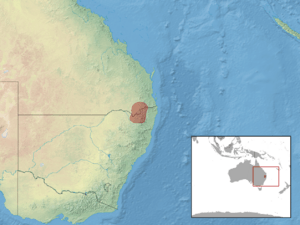Border Ranges blue-spectacled skink facts for kids
Quick facts for kids Border Ranges blue-spectacled skink |
|
|---|---|
| Conservation status | |
| Scientific classification | |
 |
|
| Synonyms | |
|
The Border Ranges blue-spectacled skink (also known as the forest skink) is a special kind of lizard. Its scientific name is Silvascincus tryoni. This skink is part of the skink family (Scincidae). It lives only in one specific area: the McPherson Range in Australia. This mountain range is right on the border between New South Wales and Queensland.
Contents
What's in a Name?
Who was Henry Tryon?
The skink's scientific name, tryoni, honors a scientist named Henry Tryon. He was an English scientist who lived from 1856 to 1943.
What Does It Look Like?
Size and Markings
This skink can grow to about 10.4 centimeters (4.1 inches) long. This measurement is taken from its snout (nose) to its vent (the opening near its tail). It has clear, dark stripes across its back. These stripes stand out against its light to medium brown body color.
How Do They Have Babies?
Live Births
Unlike some reptiles that lay eggs, the Border Ranges blue-spectacled skink gives birth to live young. This is called being viviparous. One female skink, about 10 centimeters (3.9 inches) long, gave birth to five babies. These young skinks were about 3.3 to 3.5 centimeters (1.3 to 1.4 inches) long when they were born.
Where Do They Live?
Their Rainforest Home
The Border Ranges blue-spectacled skink lives in cool, wet rainforests. These forests are found high up in the mountains. They live at elevations between 760 and 1,100 meters (2,490 to 3,610 feet) above sea level.
Finding Them in Nature
You might spot these skinks on logs or rocks. They also hide under old, decaying logs. Sometimes, they like to sunbathe at the bottom of a hollow giant stinging tree. If they feel scared, they quickly hide under rocks and logs for safety.
Are They Safe?
Conservation Status
Even though they live in a small area, these skinks seem to be quite common there. Their home is mostly within protected areas. These include Lamington National Park and Border Ranges National Park. Because of these protected spaces, the Border Ranges blue-spectacled skink is not currently facing any big threats.


